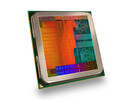AMD Radeon R7 (Kaveri) vs AMD Radeon R7 384 Cores (Kaveri Desktop)
AMD Radeon R7 (Kaveri)
► remove from comparison
The AMD Radeon R7 (Kaveri) is an integrated DirectX 12 graphics card found on a number of AMD Kaveri APUs. Depending on the APU model, the GPU can offer all 512 GCN shaders and 8 compute cores, such as on the FX-7600P. Alternatively, other APUs may only feature 384 shaders and 6 compute cores, such as on the FX-7500. Additionally, the maximum core clock and memory speeds of the GPU depend on the overarching APU: While the ULV models are limited to DDR3-1600, the standard voltage models can support up to DDR3-2133.
Architecture and Features
Thanks to the new GCN 1.1 architecture, the Kaveri GPUs are significantly more efficient with higher performance compared to its VLIW-based predecessors Richland and Trinity. The graphics card can now handle both DirectX 12 (FL 12_0) and the AMD Mantle API. The GPU is also able to accelerate various applications like Adobe Photoshop by utilizing OpenCL.
The revised video engine of Kaveri includes UVD 4.2 (Unified Video Decoder) and VCE 2.0 (Video Codec Engine). H.264 codec support has been slightly improved in several areas. However, H.265 is still not fully supported in hardware.
Performance
Due to significant differences in shader count, core clock speed, and memory support between various Radeon R7 models, the performance of the Radeon R7 can vary greatly between different APUs. While the fastest GPU version in the FX-7600P can compete with a dedicated GeForce GT 740M, the slower version in the FX-7500 only performs at the level of a GeForce GT 720M or HD Graphics 5500. In some cases, the relatively weak CPU may limit the framerates.
Accordingly, games of 2014 can be played fluently in low to medium settings at 1024 x 768 or 1366 x 768 pixels.
Power Consumption
The power consumption of the entire Kaveri APU is rated at 19 Watts and 35 Watts for ULV and standard voltage models, respectively. Thus, the 28 nm chip is suited for smaller or medium sized (sub-)notebooks.
AMD Radeon R7 384 Cores (Kaveri Desktop)
► remove from comparison
The AMD Radeon R7 Graphics with 384 Shaders is integrated in the AMD Desktop Kaveri APUs AMD A10-7700K, A8-7650K and A8-7600. It is an integrated GPU without dedicated graphics memory and is based on the GCN 1.1 (or 2.0) architecture of the Hawaii desktop graphics cards (e.g. R9 290). However, it was altered for HSA use in the APU.
In the AMD A10-7700K, A8-7650K and 7600, the graphics card offers 384 of the 512 shader cores (6 of the 8 compute cores) with a maximum core clock of 720 MHz. Without 3D load, the R7 clocks at 351 MHz. It supports DirectX 12 (FL 12_0) in hardware, which is a big advantage over some GPUs from the competition (Intel Haswell e.g. 11.1, Nvidia Kepler and Maxwell v1 11.0).
The gaming performance in our tests was quite similar to the Radeon R7 in the A10-7850K. The missing shaders did not hurt in most of the gaming tests, as the memory bandwidth limits the performance. Compared to the Intel Iris Pro Graphics 5200 (in the Schenker S413), the Radeon R7 is positioned on the same level or slightly below on average. Many current games as of 2014 can be played fluently in medium resolutions and detail settings.
Test system: Asus A88XM-PLUS mainboard, 16 GB DDR3-2133 AMD Gamer memory
| AMD Radeon R7 (Kaveri) | AMD Radeon R7 384 Cores (Kaveri Desktop) | |||||||||||||||||||||||||||||||||||||
| Radeon R (Kaveri) Series |
|
| ||||||||||||||||||||||||||||||||||||
| Codename | Kaveri | Kaveri Spectre | ||||||||||||||||||||||||||||||||||||
| Architecture | GCN 1.1 | GCN | ||||||||||||||||||||||||||||||||||||
| Pipelines | 512 - unified | 384 - unified | ||||||||||||||||||||||||||||||||||||
| Core Speed | 553 - 686 (Boost) MHz | 720 MHz | ||||||||||||||||||||||||||||||||||||
| Memory Bus Width | 64/128 Bit | |||||||||||||||||||||||||||||||||||||
| Shared Memory | yes | yes | ||||||||||||||||||||||||||||||||||||
| API | DirectX 12 (FL 12_0), Shader 5.0 | DirectX 12 (FL 12_0), Shader 5.2, OpenGL 4.3 | ||||||||||||||||||||||||||||||||||||
| Transistors | 2.4 Billion | |||||||||||||||||||||||||||||||||||||
| technology | 28 nm | 28 nm | ||||||||||||||||||||||||||||||||||||
| Features | UVD 4.2, VCE 2.0 | HSA, OpenCL 2.0, DirectCompute 5.0 | ||||||||||||||||||||||||||||||||||||
| Notebook Size | medium sized | |||||||||||||||||||||||||||||||||||||
| Date of Announcement | 04.06.2014 | 14.01.2014 |
|
| ||||||||||||||||||||||||||||||||
Benchmarks
3DM Vant. Perf. total + AMD Radeon R7 (Kaveri)
Cinebench R15 OpenGL 64 Bit + AMD Radeon R7 (Kaveri)
Average Benchmarks AMD Radeon R7 (Kaveri) → 100% n=18
Average Benchmarks AMD Radeon R7 384 Cores (Kaveri Desktop) → 133% n=18
* Smaller numbers mean a higher performance
1 This benchmark is not used for the average calculation
Game Benchmarks
The following benchmarks stem from our benchmarks of review laptops. The performance depends on the used graphics memory, clock rate, processor, system settings, drivers, and operating systems. So the results don't have to be representative for all laptops with this GPU. For detailed information on the benchmark results, click on the fps number.

F1 2018
2018
The Crew 2
2018
Team Fortress 2
2017
Dirt 4
2017
Rocket League
2017
For Honor
2017
Resident Evil 7
2017
Watch Dogs 2
2016
Battlefield 1
2016
Overwatch
2016
Need for Speed 2016
2016
Hitman 2016
2016
Far Cry Primal
2016
Rainbow Six Siege
2015
Just Cause 3
2015
Fallout 4
2015
Anno 2205
2015
FIFA 16
2015
World of Warships
2015
Metal Gear Solid V
2015
Dota 2 Reborn
2015
The Witcher 3
2015
Dirt Rally
2015
GTA V
2015
Battlefield Hardline
2015
Evolve
2015
Far Cry 4
2014
F1 2014
2014
Ryse: Son of Rome
2014
Alien: Isolation
2014
Fifa 15
2014
Sims 4
2014
Risen 3: Titan Lords
2014
GRID: Autosport
2014
Watch Dogs
2014
Titanfall
2014
Thief
2014
X-Plane 10.25
2013
Battlefield 4
2013
Total War: Rome II
2013
Saints Row IV
2013
Company of Heroes 2
2013
Metro: Last Light
2013
BioShock Infinite
2013
Tomb Raider
2013
Crysis 3
2013
Dead Space 3
2013
Hitman: Absolution
2012
Dishonored
2012
Borderlands 2
2012
Sleeping Dogs
2012
Diablo III
2012
Anno 2070
2011
Dirt 3
2011Average Gaming AMD Radeon R7 (Kaveri) → 100%
Average Gaming 30-70 fps → 100%
Average Gaming AMD Radeon R7 384 Cores (Kaveri Desktop) → 148%
Average Gaming 30-70 fps → 160%
For more games that might be playable and a list of all games and graphics cards visit our Gaming List








































